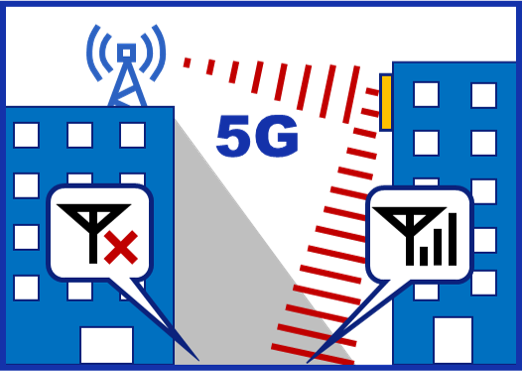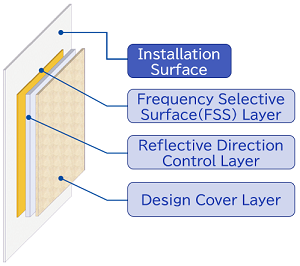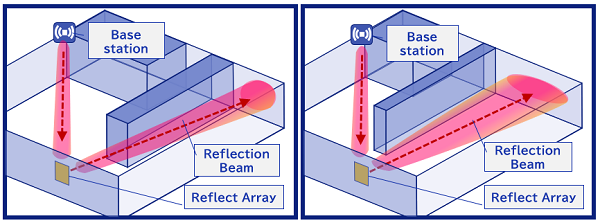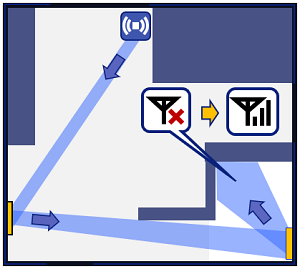Expanding the mmWave coverage area
Reflect Array for 5G
The Reflect Array developed by Dai Nippon Printing Co., Ltd.(DNP) is capable of reflecting millimetre waves (mmWave) used in fifth generation (5G) mobile communications systems in a more targeted manner compared to general metal reflectors. The new product poses fewer installation restrictions, making it possible to improve the communications environment in locations where radio waves have been difficult to penetrate, such as those in the shadow of buildings. In addition, the Reflect Array boasts superior design features allowing it to accommodate various installation-environment considerations.

See 11 related fields
Background

|
|---|
The mmWaves refers to the short wave radio frequency spectrum between 24GHz and 100GHz, which has been underused to date and which by being exploited for commercial purposes, is expected to significantly increase available bandwidth.
5G mobile communications systems use sub-6 (3.6 GHz and above) frequencies that are higher frequency than currently available 4G systems, alongside mmWave frequencies. However, while existing mmWave maintains a large information capacity, it is also characterized by high straight line properties and short reach. Therefore, radio waves are rapidly weaken in locations, such as those in the shadow of buildings, creating coverage holes that make it difficult to ensure communication quality. While it is possible to resolve this issue by adding base stations and relay equipment, a variety of new challenges emerge, such as increased costs and difficulty in securing installation space.
In answer to these challenges, DNP has developed a Reflect Array based on a proprietary concept that is cheaper and easier than to install base stations, and does not require a power source.
What is Reflect Array?

|
|---|
Based on its special structure, a Reflect Array, also known as a meta-surface reflector, can reflect radio waves of a certain frequency in an asymmetric manner. Unlike metal reflectors that reflect radio waves directly, as in a mirror image, with a Reflect Array it is possible to freely design the frequency band, the incidence angle and the reflection angle, along with the spread, or beam profile, of the reflection waves. As a result, it is now possible to improve effective radio wave conditions against coverage holes without increasing base stations.
Features
The Reflect Array developed by DNP applies superior microfabrication technology to realize special radio wave reflection features.
■Effective improvement of radio wave conditions
We have made it possible to adjust the spread of the reflection wave beam profile.
・By expanding the spread it is now possible to improve radio wave conditions over broader areas compared to other reflectors.
・It is also possible to gather reflection waves into specific devices in weak radio wave environments.
|
|
■Supports multi-step reflections
Reflected beams can be further reflected by another Reflect Array.
It is possible to deliver radio waves to areas that cannot be reached with only one Reflect Array.
|
|
■Can be installed in a variety of locations
It is possible to maintain a degree of freedom in the setting of the incidence angle and the reflection angles that are determined by the positional relationship with the base station and the coverage hole.
・It is also possible to set the corresponding incidence angle and the reflection angle even in cases where the installation space is restricted.
■Reduces the impact on existing radio waves
With the new product it becomes possible to pass through all but the targeted radio waves.
・Installation results in a low shielding impact for communications in frequency bands lower than mmWaves.
・It is also possible to set the system so as to permit the reflection of specific frequency bands only, and pass through other bandwidths, as with a metal reflector.
■Design features that can accommodate a variety of installation locations
It is possible to create various external designs, including those that accommodate interiors, exteriors and advertising signboards.
Effectiveness of DNP's Reflect Array
To confirm the effectiveness of DNP's Rreflect aArray, the effectiveness was verified at ‘the Local 5G Open Lab’, a local 5G verification environment jointly established by NIPPON TELEGRAPH AND TELEPHONE EAST CORPORATION and the University of Tokyo.
■Improved communication environment with the Reflect Array
A Reflect Array, which reflect radio waves in spot beams, were designed and fabricated for emergency staircase area where radio waves from the base station are difficult to reach. The average throughput (data transfer rate) of communication terminals in the emergency staircase area was greatly improved by the installation of the Reflect Array, both in terms of download and upload, and the maximum speed was comparable to that in front of the base station. In addition, the received power at the terminal, an indicator of signal strength from the base station, and SINR (Signal to Interference plus Noise Ratio), a measure of signal quality, were also improved, confirming that DNP's Reflect Array are effective in improving the communication environment.
|
|
■Multi-step reflection by the Reflect Array
When radio waves from the base station are reflected toward the entrance of the emergency staircase area using a Reflect Array, radio waves cannot be delivered directly to the area in the shadow of the entrance. Therefore, we installed an additional wide-reflect-beam type Reflect Array at the emergency staircase, and positioned it so that the beam reflected by the first Reflect Array (RA1) is further reflected by the second Reflect Array (RA2).
|
|
When the down link speed was measured at the position where the reflected beam of RA2 reached, the two-step reflection of RA1 + RA2 improved the download speed compared to that of RA1 alone, showing a maximum speed equivalent to that of the front of the base station. This confirms that combining multiple DNP Reflect Array can effectively expand the coverage area.
Reflect Array Composition
The Reflect Array is comprised of three layers with independent functions.

|
|---|
Frequency Selective Surface (FSS)
●Selectively reflects predetermined frequency band, while passing through other radio waves.
●Tunes characteristics in a set with the design cover.
●Compatible with various reflection angle in the same frequency band.
Receptive Direction Control Layer
●Special dielectric layer that determines the incident and reflection direction of radio waves reflected by the FSS.
●Accommodates various incident and reflection directions based on the positional relationship of the base station and any coverage hole.
●Can also accommodate reflection beam profile adjustments.
Design Cover Layer
●Protects the other two layers while maintaining the characteristics of the Reflect Array.
●Can accommodate various designs. In other words, maintains a high degree of design freedom.
●Scratch and stain resistance (interior, exterior walls, etc.)
●Possible to combine with various building materials provide by DNP.
Materials that impact radio waves may be excluded.
Usage Scene
Consideration regarding the implementation and in some cases the commercialization of 5G targeting the realization of smart cities and smart factories that exploit robots and the Internet of Things (IoT) is already underway. However, many obstructions to mmWaves exist, and we anticipate the emergence of coverage holes.
Urban areas
●Improvement of communication environments, while harmonizing with the external walls of buildings and advertising signboards.
Factories
●Improvement of the communication environment behind radio wave shielding objects in smart factories.
Business and educational sites
●Making it possible to pass through waves on an even basis in locations where mobile devices are expected to be used.
Exhibition halls
●Able to accommodate layouts and radio wave shielding conditions in locations that are rearranged on an event basis.
Stadiums and amusement facilities
●Improvement of the radio wave environment where area-limited information is delivered.
Looking Ahead
DNP will work jointly with various communications-related companies, including communications carriers, to verify the functionality of the new product, aiming for commercialization from FY 2023.
Related Link
Frequently Asked Questions
| Q:Is it possible to receive a sample for evaluation purposes? | A: Before providing such a sample, it may be necessary to consider other details, including your mmWave frequency and installation location. Please contact us for further information. |
| Q: Is the new Reflect array compatible with formats other than mmWaves? | A: At present, only mmWaves are accommodated, and there are no plans to extend this to other frequencies. However, we will do our best to respond to the specific nature of your inquiry. |
| Q: What are the prototype costs and lead time? | A: Responses will be provided on an individual basis following a consultation meeting. . Please contact us for further information. |
Please feel free to contact us for any questions.
DNP in Electronics
|
|
Other than listed above, DNP’s Electronics segment has a wide range of products for digital interface (display-related) and semiconductor.
You can check further our product line-up here and find anything to accommodate your needs.
See 11 related fields


